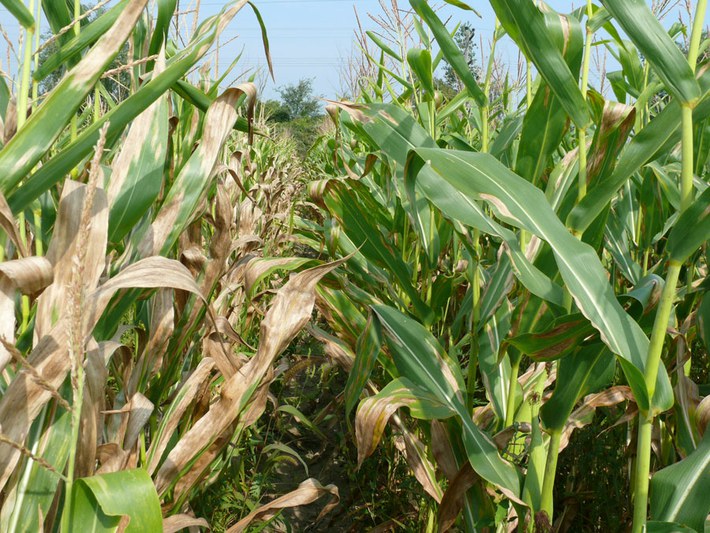Aug 9, 2017Northern corn leaf blight seen in late season planted sweet corn
Northern corn leaf blight (NCLB) is a disease caused by the fungal pathogen Exserohilum turcicum. The foliar lesions first develop on the lower leaves and are initially small, elliptical and gray-green in color. As the disease progresses the lesions will expand to 1 to 6 inches long, become tan in color and are not restricted by the leave veins. Eventually, the lesions will coalesce and cover the entire leaf. Under humid conditions, the lesions will produce dark gray spores on the lower leaf surface giving them a dusty appearance. In Pennsylvania, conditions are more favorable for disease later in the season as the temperatures start to drop and dew periods lengthen thus NCLB tends to be more problematic in later sweet corn plantings.
Symptoms are usually first observed on the lower leaves and the spread up the plant. The greatest losses from NCLB occur when severe necrosis develops on the upper 2/3 of crop canopy by silking. The reduction in photosynthesis due to the necrosis results in reduced ear fill and when symptoms develop on the husks they appear older and are less marketable.
Host resistance can still be an effective tool for managing NCLB especially for later sweet corn plantings. There are different types of resistance genes that have been introduced into sweet corn hybrids through traditional breeding (not GMOs). These various resistance genes will limit lesion size, lesion number and the amount of sporulation within each lesion.
The crop should be scouted regularly, focusing on the lower leaves where symptoms develop first. Protectant fungicides like chlorothalonil can be applied when there are reports of NCLB in the area but symptoms have not been observed in the field. Good coverage is critical. NCLB specific fungicides include those in FRAC group 11 (strobilurins; e.g. Quadris and Headline) and FRAC group 3 (triazoles; e.g. Tilt). There are also a number of products that contain both FRAC groups (11 + 3; e.g. Quilt and Stratego). Rotate between these FRAC codes and tank mix with a broadspectrum protectant for resistance management when symptoms are first observed in the field will help manage NCLB. PHIs vary between the products so read the labels carefully when the crop is near harvest. Also depending on the label, NCLB might be referred to as Helminthosporium leaf blight which collectively refers to both Northern corn leaf blight and Southern corn leaf blight.
Photo above: Symptoms of NCLB on a susceptible (left) and resistant (right) sweet corn hybrids. Photo: omafra
– Beth K. Gugino, Penn State University
Source: Penn State University Extension















